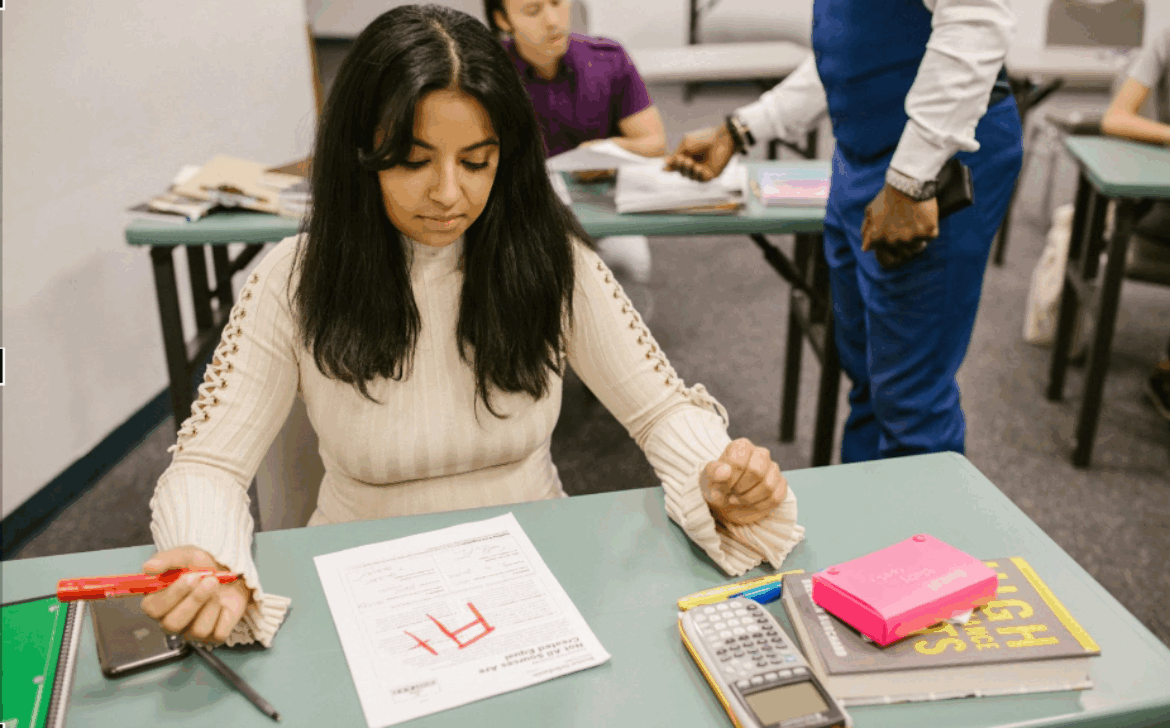SAT & ACT Test Dates 2025–2026: Deadlines, Prep Plans & Registration Tips
Included in this article:
- Why Planning the Test Date Matters
- SAT and ACT Test Dates 2025–2026 (Fall Schedule & Deadlines)
- Registration Deadlines for SAT and ACT
- Step-by-Step SAT/ACT Registration Process
- Common Mistakes When Registering for SAT/ACT
- SAT vs ACT: Which Test Should You Take?
- Top SAT & ACT Prep Tools and Resources
- SAT and ACT Prep Timeline: Plan for Test Day Success
Preparing for college admission tests may feel overwhelming, but having a clear and realistic plan can make all the difference. The SAT and ACT are critical parts of your admissions journey, and their timings can influence not only how prepared you feel but also whether your scores reach colleges before the deadlines. While it seems tough at first, a thoughtful timeline can help you balance exam prep with your schoolwork, activities, and personal commitments.
To simplify this process, this blog will walk you through everything you need to know about SAT and ACT test dates 2025-2026, how to register on time, and how to plan your preparation effectively.
Careful planning and timely registration for the SAT or ACT make the process much less stressful. By registering early, you can secure your preferred test date and location, avoid late fees and even leave room for a possible retake. Staying on top of the registration deadlines, knowing the key differences between the two exams, and following a prep plan can set you up for greater confidence on test day.
Why Planning the Test Date Matters:
Choosing your SAT or ACT test date isn’t just about picking a day that fits your schedule. It’s about making sure your scores get to colleges on time, giving yourself room for a retake, and allowing enough time to prepare steadily rather than rushing at the last minute. In fact, many students see score improvements on their second attempt simply because they are more familiar with the test format. Planning ahead also helps you balance school, activities, and prep more smoothly while avoiding unnecessary stress
Aligning Test Dates with College Application Deadlines:
Deadlines for college applications vary a lot. Early decision deadlines typically fall in November, and regular decision deadlines often range from early January to early February. Choosing the right test date ensures your scores are reported on time and helps you avoid application delays. Since many colleges require official scores by the application deadline, thoughtful scheduling is key to staying on track.
Reducing Stress and Avoiding Late Fees:
Registering early secures your preferred test date and location, sparing you the stress of scrambling at the last minute. Late registration not only comes with an additional fee but also limits your options for test centers. Proactive planning eliminates unnecessary anxiety and ensures you focus your energy where it matters most — preparation.
Allowing Time for Retakes
Even after months of preparation, some students may not achieve their target score on the first attempt. That’s why scheduling with at least one retake in mind keeps your college plans on track without added stress.
A gap of 6–8 weeks between tests allows enough time to review results, address weaknesses, and improve performance. Thanks to multiple test dates offered throughout the year, you can select the initial test date in the summer of your junior year and then follow up with a retake in your senior year.
SAT and ACT Test Dates 2025–2026 (Fall Schedule & Deadlines)
Understanding the testing schedules is perhaps the most important thing in your preparation, allowing you to select the right dates as per your comfort.
SAT 2025 Test Dates
The SAT is usually offered seven times each academic year, with test dates scattered across the calendar. SAT 2025 test dates include August 23, September 13, October 4, November 8, and December 6. These dates for the fall intake are important for students aiming to finalize their scores before college applications.
ACT Test Dates 2025
Similarly, the ACT is also available multiple times throughout the year. ACT test dates 2025 include September 6, October 18, and December 13. With multiple test dates arriving in the fall season, ACT test-takers can benefit by selecting dates that align with their personal schedules and preferred submission deadlines.
| Test Date | Test | Registration Deadline | Late Registration Deadline |
| August 23, 2025 | SAT | August 8, 2025 | August 12, 2025 |
| September 6, 2025 | ACT | August 1, 2025 | August 19, 2025 |
| September 13, 2025 | SAT | August 29, 2025 | September 2, 2025 |
| October 4, 2025 | SAT | September 19, 2025 | September 23, 2025 |
| October 18, 2025 | ACT | September 12, 2025 | September 30, 2025 |
| November 8, 2025 | SAT | October 24, 2025 | October 28, 2025 |
| December 6, 2025 | SAT | November 21, 2025 | November 25, 2025 |
| December 13, 2025 | ACT | November 7, 2025 | November 24, 2025 |
| February 14, 2026 | ACT | January 9, 2026 | January 23, 2026 |
| March 14, 2026 | SAT | February 27, 2026 | March 3, 2026 |
| April 11, 2026 | ACT | March 6, 2026 | March 24, 2026 |
| May 2, 2026 | SAT | April 17, 2026 | April 21, 2026 |
| June 6, 2026 | SAT | May 22, 2026 | May 26, 2026 |
| June 13, 2026 | ACT | May 8, 2026 | May 29, 2026 |
Registration Deadlines for SAT and ACT
Staying aware of SAT and ACT 2026 registration deadlines is crucial for keeping your college admission plans on track. Missing a deadline can mean late fees, limited test center choices, or even missing a testing window entirely. Since each exam has its own registration timeline, students should plan several months ahead to secure the best dates and locations and cost-saving options.
SAT Registration Deadlines and Fees:
The regular SAT registration deadlines fall about five weeks before the test day. The gap between the registration deadline and test day provides students with an opportunity to carefully consider the best date and center for their exam. If you miss the deadline, late registration is sometimes available up until two to three weeks before the exam, but it comes with an additional fee and fewer test center options.
- Registration Fee: $68 (base fee)
*International students pay an additional 43$.
- Late Registration Fee: $38 (additional)
ACT Registration Deadlines and Fees:
ACT registration works in a similar way. Regular deadlines for the ACT fall some four to five weeks before the scheduled test, with late registration extending closer to the test but often with fewer test center options.
- Registration Fee (no writing): $68
- Registration Fee (with writing): $93
- Late Registration Fee: $38 (additional)
Fee Waivers for SAT and ACT
Both the SAT and ACT offer fee waivers to help students from low-income backgrounds access the exams at no cost.
- SAT Fee Waivers: Provided through College Board. Benefits include free registration (with late fees waived), unlimited score reports, and college application fee waivers.
- ACT Fee Waivers: Provided through ACT.org. Students can receive up to two waivers, which cover the test fee (with or without writing), waive late fees, and include additional free score reports.
The eligibility for a fee waiver is based on family income. If eligible, you can request a fee waiver request through your high school counselor or authorized school official.It’s best to request a waiver at least a month before registration to allow enough processing time.
Step-by-Step SAT/ACT Registration Process:
Here are a few simple steps you can follow to get yourself registered for the tests:
1) Create Your Online Account:
Begin by visiting the official SAT or ACT registration website. Proceed by creating a new account, or if you already have one, simply log in using your credentials. The information you provide must be accurate and up to date.
2) Review And Choose the Test Dates:
After you have successfully logged in, you can start exploring the test dates. Each option will have a deadline for regular and late registration. Make sure to select a date that fits well with your academic schedule after carefully considering college application deadlines and how much preparation time you will need.
3) Select the Testing Centre:
You will now have to choose a test center. Choosing your test center should be done carefully while keeping convenience and accessibility in mind. Try to look for test centers near your home or school to reduce the travel time.
4) Complete Your Personal and Educational Information:
You will be asked to submit your personal and academic information next. Make sure that the information you are using is complete and accurate.
5) Pay Your Registration Fee or Apply for a Fee Waiver:
After adding all the required information, you can proceed to pay the registration fee to confirm your registration. The payment can be done entirely online, and you can even ask for a fee waiver if you are eligible.
6) Review, Confirm, and Submit Your Registration:
Now, that completes your registration process. But before you hit that submit button, take a moment to review your application carefully. Double check details like your name, date of birth, and test center, as any small mistake can cause a lot of complications.
Common Mistakes When Registering for SAT/ACT:
Registering for the SAT or ACT might seem simple, but small mistakes can lead to big headaches later. From missing deadlines to overlooking key details, many students end up with avoidable problems that cause stress or even delay their test plans. Knowing what to watch out for can help you stay on track and avoid last-minute surprises.
- Missing deadlines: Among the most common mistakes students make is not registering before the deadline. Both ACT and SAT have strict registration deadlines and missing out on can make you wait and pay more for the next exam.
- Incorrect information: Accuracy is important when it comes to filling out your application form. A small error such as putting in the wrong name, school code or date of birth can cause issues for you.
- Selecting the wrong center: Although test centers might not seem that important, choosing a center that is far away from your location can cause a lot of troubles on test day.
- Failing to submit compliant pictures: Your photo serves as a proof of your identity. Submitting a blurry or unclear photo can create issues for you in registration or on the day of the exam.
- Ignoring the confirmation email: After registration you will receive an email with all the important details. These details include the test date, location, and the reporting time. Do not ignore this email so you can avoid any confusion on the test day.
By setting up reminders and keeping important data in check, you can save yourself from making any of these mistakes.
SAT vs ACT: Which Test Should You Take?
When it comes to choosing between the SAT and ACT, there is no clear winner. Both of these exams are highly reputed for college admissions, but there are a few differences between the two:
SAT and ACT Format and Timing Differences:
Both ACT and SAT serve as benchmarks for college admission. However, they differ in formats and timing. The SAT lasts roughly two hours and 14 minutes. It assesses evidence-based reading, writing, and math. The ACT, on the other hand, has traditionally run about 3 hours (over 4 hours with the optional essay and breaks), but starting in 2025 it is shifting to a shorter, enhanced format of about 2 hours and 15 minutes for most test-takers.
Students can choose either of the two tests to match their academic strengths and pace. If you prefer more time to analyze each question, the SAT might be better for you. But if you perform well under time pressure and enjoy science-based questions, the ACT could be the right choice for you.
Comparison of Scoring Scales:
The SAT scoring totals between 400 and 1600 points by combining the two main section scores. ACT averages the scores of four sections into a range between 1 and 36. Both scales hold equal weight in college admission.
College Acceptance and Test Policies:
Almost all colleges across the United States accept both the ACT and the SAT. However, a few universities might prefer one over the other. It is smart to research the specific colleges you are aiming for to inquire which test would be preferred.
Choosing Based on Strengths:
The smartest way to go about selecting the type of test you want to take is by taking practice exams. A full-length practice test will reveal a lot about your strengths and will help you in deciding the type of test you want to go for. A practice test will also develop your test-taking stamina and will get you used to taking the test.
Top SAT & ACT Prep Tools and Resources
Test prep can be overwhelming, but in today’s age, there are a lot of online tools and resources that can help you in your SAT vs ACT prep without having to rely on yourself for the most part. These resources include:
Free Official Practice from College Board & ACT:
For students at the beginning of their prep journey, official sources are the best place for a smooth start. The College Board is an official website that will provide you with practice questions, sample tests, and preparation guides that resemble the actual exam.
Similarly, the official ACT website offers a lot of resources, including test day tips, practice tests, and even a detailed breakdown of the exam format.
Paid Prep Tools and Apps:
Beyond free online resources, there are many paid tools to help you. Platforms like Magoosh and Princeton Review provide structured online courses, timed practice, and detailed feedback. These are especially useful if you want extra test simulations and organized study schedules.
Personalized Tutoring:
Hiring a personal tutor can be even more beneficial, as a lot of students cannot make the most out of online studies. A skilled personal tutor can provide customized strategies, targeted practice, and accountability through one-on-one sessions. For personalized tutoring, you can take advantage of platforms like Prep Excellence, alongside others.
SAT and ACT Prep Timeline: Plan for Test Day Success
Preparing for the SAT or ACT isn’t just about studying hard—it’s about studying smart. A well-thought-out timeline helps you stay consistent, avoid burnout, and walk into test day feeling confident. Here’s a simple way to break your prep into stages that build on each other:
Step 1: Build Your Foundation
Start 3–6 months before your test date. In this stage, focus on strengthening the basics—review grammar rules, math fundamentals, and core reading skills. This groundwork makes tougher practice later much easier.
Step 2: Practice Under Timed Conditions
Once you’re done with fundamentals, move on to full-length practice and timed mock tests, ideally under exam-like conditions with limited breaks. This helps you adjust to the pace of the SAT or ACT, improve time management, and learn how to stay focused under pressure.
Step 3: Target Weak Areas
In the final weeks, use your practice test results to identify where you struggle most. Spend extra time on those sections while keeping your stronger areas fresh. By sharpening your weak spots, you maximize your overall score potential.
Final Thoughts
Preparing for your SAT and ACT does not have to come with a lot of complications. With early planning, proper scheduling, and a structured timeline, you’ll feel more prepared and confident on test day. Remember that aligning your test dates with college deadlines and staying ahead of registration deadlines is important. You should also leave some room for a retake for a smooth and successful journey.
If you need extra guidance, feel free to reach out to the SAT/ACT experts at Prep Excellence. From test prep strategies to personalized tutoring, our team can help you maximize your potential.



